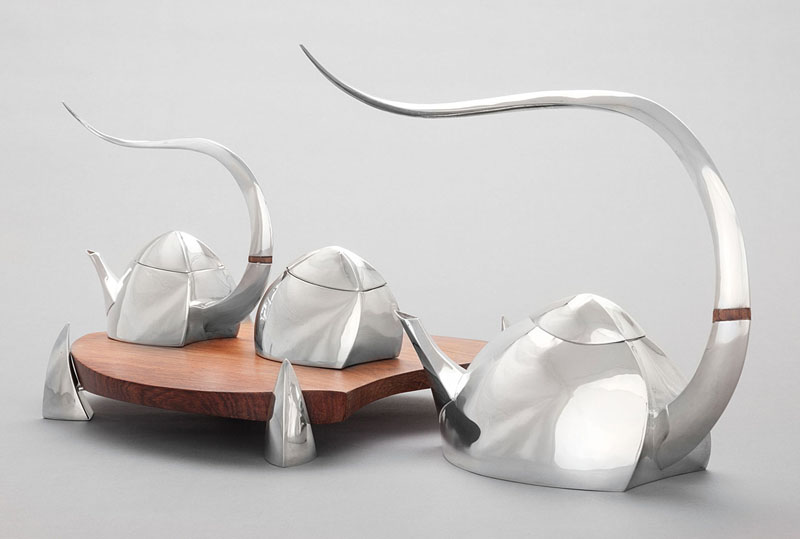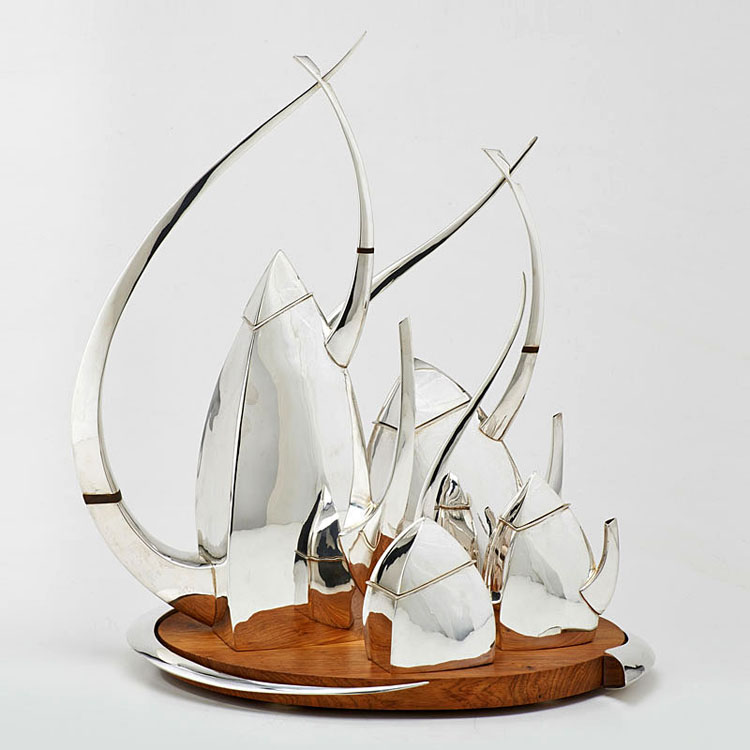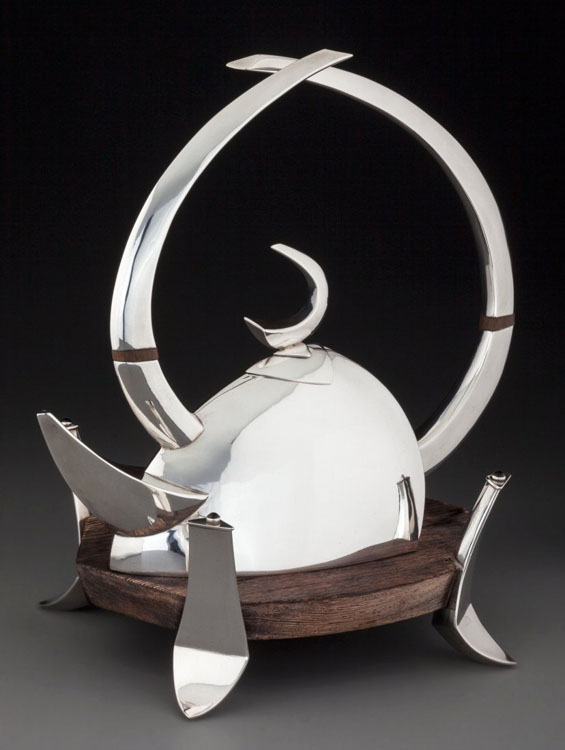“The vessels of Michael and Maureen Banner resemble nothing so much as the perennial flowers that surround their rural Massachusetts home and studio…They seem to arise with a candid grace – impulsive as clematis, insistent as lilies.”[i]
When this husband-and-wife team began collaborating in the late 1960s, they had little knowledge of where this venture was going to take them. Over the years the Banners would build “an amazing life” together making jewelry and metalwork that is skillfully crafted, undeniably modern, and organic in nature.[ii] Their holloware, which is the primary focus here, is known for embracing “rounded forms that move and flow” as well as “the gestures and lines of the natural world.”[iii] A signature Banner vessel has their trademark dual handles that gracefully reach upward curling and curving through space. This is harmoniously paired with a body that grounds the form. For the Banners, a balanced design is of the utmost importance. This is not only for aesthetic reasons, but for utility as well. Their vessels must function effectively. Michael once stated, “I’ve always believed that crafts have to work.”[iv]
FOUNDATIONS
In the late 1950s Michael, who had never taken an art class, signed up for jewelry to fill a credit at Western Michigan University.[v] This experience would change the trajectory of his life. Growing up he had always made things with his hands, but until that class he had not considered jewelry as a potential career path. Not long after, Michael went to his dad, who was “a country doctor,” and told him he was not going to be a dentist.[vi] Instead, he was going to become a jeweler.[vii] His father responded, “be a damned good one.”[viii]
Michael continued his studies in metal at the Cleveland Institute of Art, where he learned how to enamel and create hollowware under the tutelage of Kenneth Bates, Frederick Miller, and John Paul Miller.[ix] The curriculum in Cleveland was geared towards designing for industry. Students, upon completion of the five-year program, would be prepared to work for a silver manufacturer such as Reed & Barton. Michael, however, only stayed for nine months. In this short period of time, he not only learned the basics, but also seemed to find encouragement. John Paul Miller, especially, was “a dream.”[x] Michael fondly remembers his teacher even helping him set up a studio space in his small apartment.
Maureen, on the other hand, grew up with a strong two- and three-dimensional arts background. Her mom was a potter, and she was also drawn to clay. In her youth Maureen attended the Art Institute of Chicago’s Junior School and later studied at Northern Illinois University and the Evanston Art Center with Paul Wieghardt, Nelli Bar, and Leo Segedin.[xi]
COLLABORATION
Michael and Maureen were married in 1968. Not long afterwards they began collaborating in metal.[xii] Essentially, the couple just wanted to “be together.”[xiii] Maureen, who is “more adventurous design-wise,” brought a “looser” quality from her work in clay, sculpture, and painting, while Michael’s metal background yielded a more “steady” and “tighter” approach.[xiv] These individual qualities harmoniously united and the combination of their talents “pushed them in new directions.”[xv] The Banner’s first studio was in a neighborhood near Chicago’s Wrigley Field.[xvi] Eventually they moved to Glencoe, a North Shore suburb of the Windy City, where the market for jewelry was good.[xvii] In 1977 the couple would relocate again, settling among the Berkshire Mountains in Massachusetts.[xviii] While this wooded landscape was appealing so was this setting’s close proximity to Boston and New York. Both places were potentially strong markets for their work.

Over the years craft shows would play an important role in the Banner’s lives. The American Craft Shows, which were sponsored by the American Craft Council, “changed the existence of a generation of craftspeople. Suddenly, there was a marketplace for [their] work, where none had existed before.”[xix] These shows created a sense of community. Not only did they bring artists together, but lasting relationships were formed between buyer and seller. Visitors to these craft shows were people who strongly supported all the arts and were interested in learning about the artwork.[xx] The Banners, at their peak, were doing up to fifteen shows a year which certainly was a grueling schedule. At these shows their focus initially was jewelry, especially earrings which were their “bread and butter.”[xxi] In addition, they sold jewelry wholesale, which had them at one point producing about nine thousand earrings over a twelve-month period.[xxii]
Eventually it became more and more difficult to get into craft shows with just jewelry. There were thousands of jewelers selling their work. The Banners were looking for something that would make them stand out. A friend suggested teapots, and after they saw a teapot exhibition at the Whitney Museum of American Art, they decided why not?[xxiii] Their first teapot was created around 1980. Michael drew from his time as a student and early pieces reflected the strong Scandinavian design aesthetic present at the Cleveland Institute of Art. It was “fun” to revisit holloware, but it was also “hard work.”[xxiv] It took about ten years and “lots of practice” to “[perfect] their technical and design skills” and to “feel competent.”[xxv] In order to focus on the teapots, the couple cut back on craft shows and stopped producing wholesale jewelry.
When the Banners began a teapot, first there was an in-depth discussion about the potential design. Instead of producing the same form repeatedly, they liked to challenge themselves and come up with new ideas.[xxvi] While sharing their thoughts, Maureen would begin sketching and Michael would do the “verbalizing.”[xxvii] These sketches evolved “until something started clicking or some part of a sketch clicked.”[xxviii] This would become a “point of departure” for the design.[xxix] With a viable concept, the Banners would then create a three-dimensional model using Bristol Board.[xxx] This gave them a better sense of the size, volume, and “a feel for the angles.”[xxxi] Next, Michael began to create the body of the vessel in silver utilizing 18-gauge sheet or heavier. Once this part was formed and soldered together, Maureen would sketch and redefine the concepts for the adjoining parts such as the spout or handle. Afterwards, Bristol Board models are made from these new sketches and the finalized silver shapes are created and assembled. If they were working on a tea or coffee service, the largest vessels would be concentrated on first. A sugar bowl or creamer would be the last form developed and would echo their larger counterpart’s design.


KAMM TEAPOT COLLECTION
There are fifteen works by the Banners in the Kamm Collection. Dating from the 1980s to 2010, this group contains single teapots as well as sizable coffee and tea sets. These objects often feature enamel work done by Maureen, which adds a touch of color, and when necessary, a rosewood heat stop is included which keeps the handles from getting hot.[xxxii] The richly hued rosewood is also frequently used to create their trays. Overall, this is an impressive collection and as you study the intricacies of the works it becomes clear that this couple “[loved] making teapots.”[xxxiii] The Banners felt these vessels in particular just “[offered] a huge range of possibilities.”[xxxiv]
The first teapot that the Kamms collected was called Melon (1997). Acquired at the American Craft Exposition in Evanston, Illinois, this design ignited their passion for the Banner’s work. Melon, which was predominately highlighted in The Artful Teapot exhibition, was part of a series where the silver body of the construction was spun. At times, Michael would get the silver “spun then [he would modify] the form to get the shape [he] wanted.”[xxxv] This “saved dozens of hours of raising…with the same results.”[xxxvi] Melon has an intersecting sculptural overtop handle that curves above its domed body. Perched on top of the lid, the finial extends upward like a gourd’s stem.
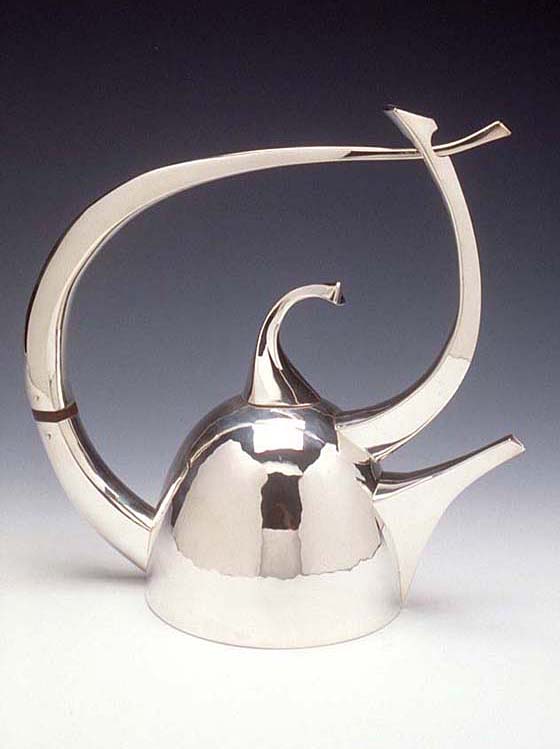

In the 1980s the Banners began playing with their signature two handled concept. At the time the couple was also making large collar necklaces. They had one of these necklaces apart and Maureen happened to hold the two pieces above a teapot. She said, “look, handles” and “bingo” the idea was born.[xxxvii] These appendages rise above the pot creating not only height, but also a “feeling of openness.”[xxxviii] Inspiration for these handles came frequently from nature, especially their garden and the wooded landscape around their home. Within the Kamm Collection there are some early examples of teapots with dual handles dating from the late 1980s. These appendages, which include rosewood heat stops, reach upward, and sweep back in space like they are blowing in the wind. In these instances, the couple was still playing with ideas. These were some of the first pieces to incorporate enamel accents and they utilized six-inch-wide silver sheet in their designs, which was all the Banners “had on hand.”[xxxix]
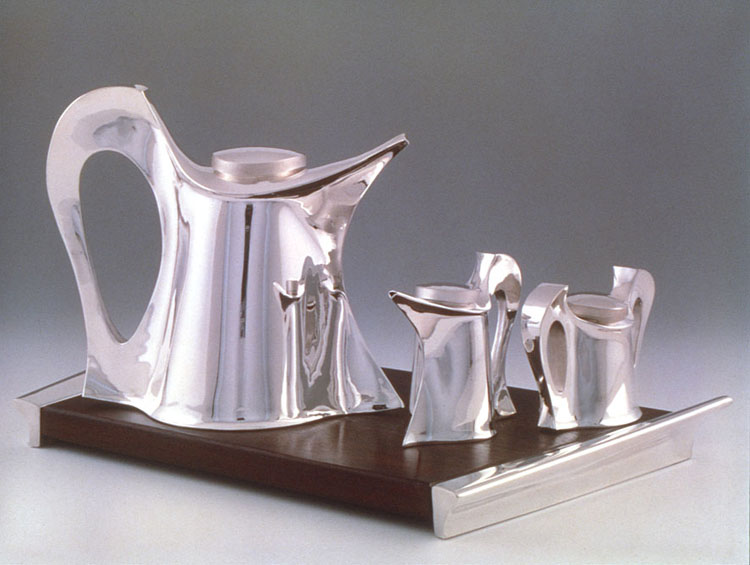
In 1991 the Banners created a service which the Kamms acquired in 2003. The set, which includes a teapot, a sugar bowl, a creamer, and a tray, was made for the Evanston Art Fair in Illinois. When the work was shipped back to the Banners after the fair, it was placed in two separate boxes. The box with the silver pieces was lost. Years later Sonny Kamm discovered the tea set on Ebay. However, the sugar bowl was missing its lid. Sonny arranged to have Michael remake the lid and the set was rejoined with its accompanying Peruvian walnut tray. Because of this history, Sonny gave the work the name Resurrection Tea Set. When this one-of-a-kind grouping was created, the Banners were exploring what would happen if you created a teapot with two sides where everything was one piece. This was a project that Michael gave himself.[xl] The form has a flowing body, a tapered spout, and a looping handle.
Another impressive work in the Kamm’s collection is Silver Sails (1999-2000). It was the first of a series of similar designs which seem to find inspiration in the lines of a sailboat’s sail. This set, which includes a coffee pot, teapot, a sugar bowl, and a creamer, was “complicated.” [xli] It took many months of long hours to complete. The vessels sit upon a rosewood tray and rosewood heat stops are included in the handles when necessary. In this instance the dual handles intersect through a pierced section at the top of the design. Proportion and balance are key here. In this instance, the Banners did not use sketches. Instead, they just played with taped Bristol Board patterns and slowly the work evolved.
While there are so many other works to discuss, we will look at just two more pieces in the collection, Great Horned Teapot (1999) and Tales of Michaelman (2008-2009). The vessels in both works have flat bottoms which ground them to the earth, a concept the Banners explored in a series of pieces. The Great Horned Teapot also plays with curved horn-like forms. Shapes echo each other sweeping upward. Even the lid’s crescent finial replicates the arc of its handles. The vessel’s accompanying oval tray, which is made of Macassar ebony, hovers above the ground perched on legs which additionally curve outward. For Tales of Michaelman, the Banners were inspired by the opera The Tales of Hoffmann. The work includes a teapot, a sugar bowl, a creamer, and a tray made of rosewood. Michael has described this service as “a very horizonal forward moving piece.”[xlii] The Banners “decided to not use any enamels, liking the stark, all silver look.”[xliii] Balance is, of course, of utmost importance here in order for the pot to properly hold and pour its liquids.
RETIREMENT
Throughout the course of their career, the Banners have deservedly received numerous commissions, grants, and accolades. Their work is featured in numerous private and public collections including the Mint Museum of Art in Charlotte, NC, the Smithsonian American Art Museum’s Renwick Gallery in Washington, DC, and the Art Institute of Chicago. Today the Banners continue to live on their fourteen wooded acres in the Berkshire Mountains. Over the years this home and studio has allowed them to work together, but also, at times, independently on their own projects. The couple retired from craft shows in 2013 and they are not making holloware anymore. However, the jewelry and metalwork the Banners created together endures revealing their tremendous skill, ingenuity, and years of dedication.
Further Reading/Viewing:
Banner Video. 18 May 2009.
Clark, Garth. The Artful Teapot. New York: Thames & Hudson, Ltd., 2001.
Silversmiths Create Graceful Teapots. 25 October 2011.
Notes:

